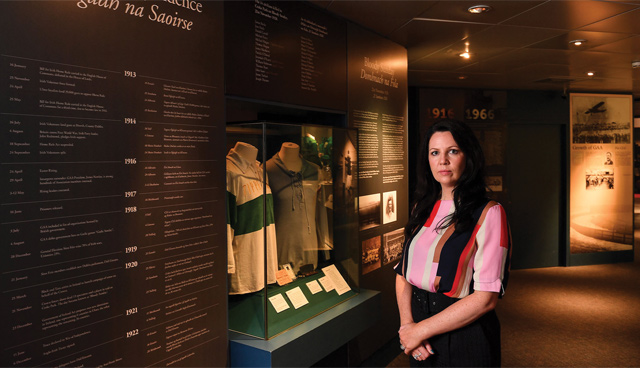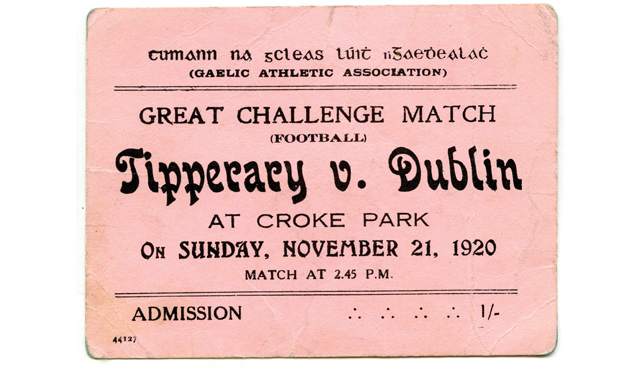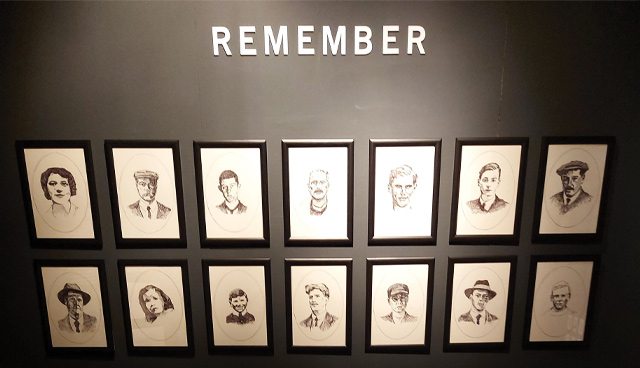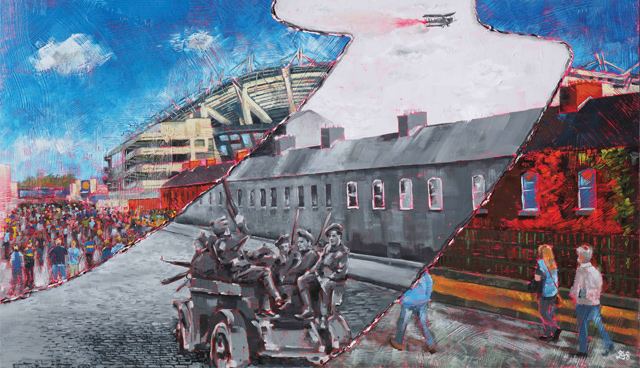Remembering the GAA’s darkest day: Bloody Sunday 1920

Bloody Sunday 1920 is a moment in time seared into the Irish psyche. On 21 November 1920, 90 seconds of shooting claimed the lives of 14 people and wounded 60 more, elevating Croke Park from sporting field to hallowed ground. Ciarán Galway speaks with GAA Museum Director Niamh McCoy about curating a commemorative programme to enhance understanding of the event and its victims.
Amid the ongoing War of Independence, a wave of violence, culminating in the deaths of 33 people across Dublin, ensured that 21 November 1920 would be collectively remembered as one of Ireland’s Bloody Sundays. As well as being the epicentre of Ireland’s national games and the third-largest stadium in Europe, Croke Park is a War of Independence lieu de mémoire.
On the morning of Bloody Sunday 1920, the IRA in Dublin executed a plan to disrupt the British intelligence network in the capital. The IRA’s Chief of Intelligence, Michael Collins, tasked ‘The Twelve Apostles’ with assassinating 20 British intelligence agents across eight locations in the city. In total, 15 men were killed and one mortally wounded while an additional five survived.
That afternoon, in an act of retribution, Crown Forces entered Croke Park during a challenge game between the Dublin and Tipperary footballers and opened fired on the 10,000 people gathered there. In the panic, 14 people were killed, including three children, while over 60 were injured. This was followed later that the evening with the execution of two high-ranking IRA officers and a civilian in Dublin Castle.
To mark the centenary of Bloody Sunday, the GAA Museum, as the national custodian of the GAA’s archives and artefacts has coordinated a commemorative programme. “The GAA Museum has an educational remit and wanted to present the facts, tell the story again and bring it to new audiences. The main focus of our event programme was remembering the victims,” explains Museum Director, Niamh McCoy.

From the perspective of the GAA Museum, the commemorative programme has three main objectives. The first is to remember the victims and bring their names back into public consciousness. The second is to educate and, as such, a series of lectures has been organised. The third is to promote reconciliation.
While Tipperary fullback Michael Hogan’s story is renowned and his name immortalised in Croke Park’s Hogan Stand, the GAA Museum is keen to ensure that the stories of the other 13 victims now receive appropriate recognition.
“The other 13 people were much like any fans attending a sporting event of a weekend. They were civilians; we wanted to tell their story,” the Museum Director emphasises.
Exhibition
As the cornerstone of the overall programme, the GAA Museum has curated a comprehensive Bloody Sunday exhibition, telling the story of the entire day through artefacts which include, among other items, newspaper reports, photographs, letters, the referee’s whistle and an original match ticket.
“Originally, we had anticipated that the programme of events, including walking tours, would take place in the museum in Croke and visitors would then visit the exhibition. We have Tom Hogan’s coat that he was wearing on the day, a prayer book, a crucifix belonging to Thomas Ryan and a lot of correspondence sent to the family of Michael Hogan family. We also have the burial register on loan from Glasnevin Cemetery Museum. It’s a very large leather-bound book and includes the entries for six of the victims. All these artefacts help bring the story to life,” McCoy states.
However, the centrepiece of the Museum’s exhibition is a collection of portraits of each of the 14 victims, including interpretations for those whom no known photographic record exists. “It’s poignant that they’re all represented together in that way,” says McCoy.
The Museum was also keen to incorporate a legacy component into its centenary programme. As such, it commissioned the GAA’s current eLearning Manager and talent artist, David Sweeney, to produce a painting to mark the occasion. The erstwhile Dublin senior hurling captain subsequently painted ‘Transilience’.
“We weren’t prescriptive and David formulated the idea. The revolutionary years were a turbulent time for the GAA but it survived and 100 years on, the Association is thriving. His painting juxtaposes the images of contemporary Croke Park on the day of Bloody Sunday as a layer of history below a modern Croke Park on matchday. It’s included in the exhibition and it’s something that will be there forever,” explains McCoy.
Education
As necessitated by such a complex element of the revolutionary era, the GAA Museum has endeavoured to comprehensively engage in multiperspectivity and deliver the story to new audiences. Simultaneously, in compiling its programme, the Museum Director was cognisant of the need to remember Bloody Sunday with respect and sensitivity.
“The Museum primarily focuses on the history of Gaelic games, brilliant matches, incredible teams and their sporting achievements. We don’t usually deal with an event like Bloody Sunday which was something of watershed moment in a conflict scenario.

The names of those who were killed in Croke Park on Bloody Sunday 1920:
- James Burke
- Daniel Carroll
- Michael Hogan
- James Matthews
- Jerome O’Leary
- Tom Ryan
- James Teehan
- Jane (Jenny) Boyle
- Michael Feery
- Thomas (Tom) Hogan
- Patrick O’Dowd
- William (Perry) Robinson
- John William (Billy) Scott
- Joseph Traynor
“It was such a tragic event. We are acutely aware that it is a very emotive subject and have been mindful in how we presented the programme and the appropriateness of the language that we used. We have sought to present the facts as objectively as possible,” she notes.
In August 2020, the GAA Museum’s annual summer school examined the theme of sport, peace and reconciliation. The panel included DKIT historian Richard McElligott, former Armagh footballer and Ulster GAA’s Head of Club and Community Development Diarmuid Marsden, and Gareth Harper from Peace Players.
Subsequently, a lecture series organised by the Museum was opened by UCD historian Diarmaid Ferriter who delivered a contextualisation of Ireland in 1920. Running from September 2020 to November 2020, other lecturers in the series include Anne Dolan from TCD, Will Murphy from DCU, Fearghal McGarry from QUB, UCC’s Ciara Chambers and Siobhán Doyle from TU Dublin.
Likewise, during the Hedge School at the GAA Museum event in November 2020, History Ireland Editor Tommy Graham will host a round table discussion of history, memory and Bloody Sunday 1920.
From a community perspective, the Croke Park Community Team is collaborating with an organisation called Fighting Words. An ongoing intergenerational project, predicated on speaking with older community members around Croke Park, aims to record the recollections of Bloody Sunday that may have been passed down by word-of-mouth. The intention is to collate an oral history and produce a book co-written by the participants.
“It’s brilliant to get support from people with this kind of knowledge and who want to engage with the museum to help it produce this programme of events. We couldn’t do it without them.
“Historians, artists and communities have been crucial to this programme. We’ve enlisted lecturers that we know are experts. Again, because of our educational remit, we know that they can help us deliver really interesting and compelling content,” McCoy remarks.

The revolutionary years were a turbulent time for the GAA but it survived and 100 years on, the Association is thriving.
Overcoming challenges
With its own board of directors and a clear remit within the wider Association, the GAA Museum was confident in its delivery of the centenary programme. However, the Covid-19 pandemic has disrupted Ireland’s tourism sector unlike any other time in living memory.
While the Bloody Sunday exhibition had only opened several days before public health restrictions once again closed museums across the country, it will remain in situ throughout 2021. Meanwhile, the series of events originally intended to take place within Croke Park, including the lecture series, History Ireland’s Hedge School and the Fighting Words initiative have all successfully pivoted online.
“Nobody could foresee the challenges ahead with the Covid-19 pandemic. The important thing is that the programme will continue to take place and one positive consequence is that because the lectures have migrated online, accessibility has been greatly enhanced. Initially, we had limited tickets because of public health restrictions. Now we can distribute the content to a greater audience.
“Like other organisations in the tourism industry, the Museum has contingency plans if it reopens in the next number of weeks. Though the main priority is simply to get back on an even keel, reaching out to audiences that typically visit us and doing what we do best. We’ll do as much as we can within the public health restrictions at any given point in time,” McCoy concludes.
Profile: Niamh McCoy
Niamh McCoy is responsible for all the activities in the GAA Museum and Tours. A proud Meath woman, McCoy has worked in Croke Park for 15 years, initially selling corporate tickets before assuming the role of GAA Museum Director. “First and foremost, I work with a great team. It’s a great place to work because we all have shared interests and everyone is committed to the role. If you work in the museum, you’re interested in the GAA and you’re interested in history,” she says.





